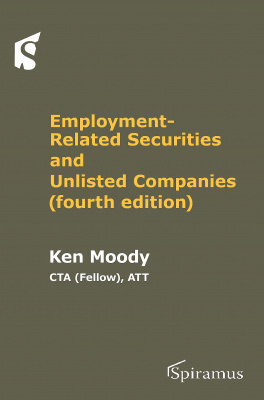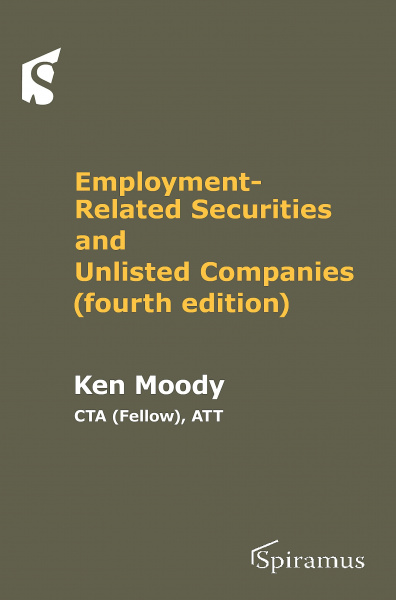Employment Related Securities and Unlisted Companies
Fourth Edition
Employment-Related Securities and Unlisted Companies is written with mainly private or unlisted companies in mind and explains in depth how the employment related securities (‘ERS’) rules in ITEPA 2003, Part 7 apply to employee share acquisitions generally, including:
- Securities as earnings
- Restricted or convertible securities
- Securities acquired for less than market value
- Securities disposed of for more than their market value
- Post-acquisition benefits connected with securities
- Securities acquired under options
The book also explores employee share acquisitions through various means, the relevant capital gains tax rules and corporation tax relief for employee share acquisitions. Basic share valuation methodology is discussed and though PAYE and NICs do not apply generally to unlisted company shares/securities, they may apply where a market exists for the securities or on the occurrence of events related to ERS. Lastly, the compliance requirements with regard to online registration of schemes, annual returns, penalties etc, are also featured.
- AvailablePaperback9781913507107424 pagesList Price: GBP 70.00 Add to basket
- AvailablePDF9781910151723424 pagesList Price: GBP 35.00 Add to basket
The main aim of this work is to provide comprehensive analysis of the Employment Related Securities (ERS) legislation at ITEPA 2003, Part 7, drawing on the legislation itself, HMRC guidance and the author’s own thoughts and experience. The focus is on unlisted companies though the commentary is relevant to awards of ERS and ERS options in general.
Chapters 2 to 4 of Part 7 are principally anti-avoidance legislation applying to:
- Restricted or convertible securities
- Securities acquired for less than market value
- Securities disposed of for more than their market value
- Post-acquisition benefits connected with securities
Chapter 5 of Part 7 concerns ERS options, while the rest of Part 7 mostly contains the detailed rules relating to awards of shares and share options under the tax-advantaged employee share schemes: SIPs, SAYE options, CSOP and EMI.
A chapter of this work is devoted to each chapter of Part 7, again with the emphasis on unlisted companies where for example the restricted securities rules at Chapter 2 are highly relevant. Of the tax-advantaged share schemes, EMI (Enterprise Management Incentives) in Chapter 5, is mainly used by unlisted companies due to the financial and other limits applicable. Major coverage is therefore given to those chapters of Part 7.
However, this work would not be complete without also analysing other tax legislation relevant to ERS and ERS options in general, including:
- ERS as general earnings for income tax purposes
- The capital gains rules relevant to ERS and ERS options
- The corporation tax deduction for acquisitions of ERS
- PAYE and NICs aspects
Additional chapters of this work therefore cover those areas in some detail. A review of the decisions of the tax tribunals and courts concerning arrangements or ‘schemes’, aimed at avoidance of income tax and NICs involving ERS, also seems on-topic and merits a chapter of its own.
Part 7 is in parts complex and confusing legislation, but some understanding of which is essential for professionals advising companies of any size. The detailed commentary in this work aims to provide its target audience with as complete a guide as possible to both the technicalities and the practicalities involved in both the interpretation and the application of the ERS rules.
Contents
Abbreviations
Table of authorities
1 Introduction to taxation of ERS and related matters
1.1 Introduction to the 4th edition
1.2 ITEPA 2003, Part 7 and tax avoidance
1.3 Terminology
1.4 Overview and history of the legislation
1.5 ERS and taxation of earnings
1.6 History and commencement of the legislation
1.7 Finance (No.2) Act 2005 and tax avoidance
1.8 Finance Act 2006
1.9 From 2006 to the present
1.10 HMRC guidance
2 Definitions
2.1 Scope of the legislation
2.2 Negative Amounts
2.3 Meaning of securities
2.4 Definition of market value
2.5 Consideration
2.6 The definition of employment-related securities
2.7 Bonus issues & replacement securities
2.8 Rights issues
2.9 Associated persons
2.10 Exclusions: public offers
2.11 Employee-controlled companies
2.12 Duty to provide information
2.13 Penalties
2.14 Assessment of penalties and appeals
2.15 Reportable events
2.16 Responsible persons
3 Reporting and other compliance requirements
3.1 Registration and annual returns
3.2 Occasions when no report is required
4 Restricted Securities
4.1 Introduction and overview
4.2 What are restricted securities?
4.3 Shares accepted as unrestricted – HMRC guidance
4.4 Statutory exclusions
4.5 No charge on acquisition in certain cases
4.6 Chargeable events and amounts chargeable
4.7 Some observations
4.8 Relief for NICs election and agreements
4.9 Exclusion for certain control situations
4.10 Elections to opt out of Chapter 2
4.11 Election on occurrence of a chargeable event
4.12 Pro forma elections
4.13 Shares acquired under tax-advantaged share arrangements
4.14 Avoidance cases – section 431B
4.15 Managers’ equity investments and carried interest in limited partnerships
5 Convertible securities
5.1 Introduction
5.2 Convertible securities
5.3 Adjustment of charge
5.4 Chargeable events
5.5 Amount of charge
5.6 Amount of gain
5.7 Consideration given for a right to convert
5.8 Case outside section 438 charge
5.9 NICs election
5.10 PAYE and NICs
5.11 Interaction with other chapters of Part 7
6 Securities with artificially depressed or enhanced market value & other tax charge
6.1 Securities with artificially depressed market value
6.2 Other tax charges
6.3 Securities with artificially increased market value
7 Securities acquired for less than market value
7.1 Introduction
7.2 Nil paid and partly paid shares - general
7.3 Company law
7.4 Loans to participators
7.5 Application of Chapter 3C
7.6 Cases which are outside Chapter 3C
7.7 Notional loan
7.8 Amount of notional loan
7.9 Discharge of notional loan
7.10 An unfortunate anomaly
7.11 Interaction of Chapter 2 and Chapter 3C – extended illustration
7.12 CTA 2010 section 455
8 Securities disposed of for more than market value
8.1 Introduction
8.2 When Chapter 3D applies
8.3 Amount chargeable
8.4 Fair market value
8.5 Gray’s Timber
8.6 Earn-outs
8.7 Company purchase of own shares
8.8 Chapter 3D in the ‘real’ world
9 Post-acquisition benefits from securities
9.1 Introduction
9.2 The charge
9.3 Exclusions from the charge
9.4 Meaning of ‘benefit’
9.5 Finance (No 2) Act 2005 changes
9.6 Are dividends within Chapter 4?
9.7 PA Holdings decision
9.8 PA Holdings and Chapter 4
9.9 ‘Alphabet’ shares
9.10 A double tax charge?
9.11 Whether ‘something has been done’
9.12 Other Chapter 4 situations
10 University spin-out companies
10.1 Introduction
10.2 Application of Chapter 4A
10.3 Tax relief on acquisition
10.4 Tax relief following acquisition
10.5 Scope of relief
10.6 Disapplication of Chapters 2 and 3B
10.7 Definitions
10.8 Capital gains tax
11 Securities options
11.1 Introduction
11.2 Definitions
11.3 Chargeable events
11.4 Amount of charge
11.5 Deductible amounts
11.6 Employer’s NICs paid by employee
11.7 Exchange of options
11.8 Earn-outs
11.9 Interaction with other chapters of Part 7
12 Share incentive plans
12.1 Introduction
12.2 The advantages
12.3 Types of share awards
12.4 Introduction to Schedule 2 and general requirements
12.5 Eligibility of individuals – Part 3
12.6 Types of shares which may be awarded – Part 4
12.7 Free Shares – Part 5
12.8 Partnership shares – Part 6
12.9 Matching shares – Part 7
12.10 Cash dividends and dividend shares – Part 8
12.11 Trustees – Part 9
12.12 Notification, annual returns and enquiries – Part 10
12.13 Disqualifying events – Part 10A
12.14 Supplementary provisions – Part 11
13 SAYE Options
13.1 Introduction
13.2 The SAYE ‘code’
13.3 Introduction– Part 1
13.4 General requirements – Part 2
13.5 Eligibility of individuals – Part 3
13.6 Shares to which schemes can apply – Part 4
13.7 Requirement for linked saving arrangements – Part 5
13.8 Requirements etc relating to share options (Part 6)
13.9 Exchange of Options – Part 7
13.10 Notification of schemes, annual returns and enquiries – Part 8
13.11 Supplementary provisions – Part 9
13.12 Corporation tax
14 Company Share Option Plan
14.1 Introduction
14.2 Summary
14.3 Exercise within three years - circumstances
14.4 Application
14.5 No charge on exercise
14.6 Charge where option offered at a discount
14.7 Introduction to Schedule 4
14.8 Exchanges of options
14.9 Notification of schemes
14.10 Annual returns
14.11 Notices and returns to be given electronically
14.12 Penalties, enquiries etc
14.13 Interaction with EMI
14.14 CSOP and Capital Gains Tax
14.15 PAYE/NICs
14.16 Deemed section 431 election
14.17 Corporation tax relief
15 Enterprise management incentives
15.1 Introduction & overview
15.2 Key advantages
15.3 Requirements - overview
15.4 Capital gains tax
15.5 The EMI ‘Code’
15.6 Market value
15.7 Option price is market value
15.8 Option price is less than market value
15.9 Disqualifying events
15.10 Tax charge following a disqualifying event
15.11 Section 431 elections
15.12 Seeking ‘comfort’ in advance
15.13 Corporation tax relief
15.14 Schedule 5 requirements: qualifying options
16 Supplementary Provisions About Employee Benefit Trusts
17 Capital gains tax and ERS
17.1 Introduction
17.2 The market value rule
17.3 Relevant income tax charges
17.4 Unrestricted shares
17.5 ERS Options
17.6 Restricted or convertible securities
17.7 Shares in research spin-out companies
17.8 Priority share allocations
17.9 Effect on transferor
17.10 Options
17.11 Application of section 119A in certain circumstances
17.12 Business Asset Disposal Relief (formerly Entrepreneurs’ Relief)
18 The corporation tax deduction
18.1 Introduction
18.2 Basic requirements under Part 12, Chapter 2
18.3 Relief for options – basic requirements
18.4 Additional relief for restricted shares
18.5 Additional relief for convertible securities
19 Employment-related securities and PAYE/NICs
19.1 Introduction
19.2 PAYE – Readily convertible assets
19.3 Readily convertible assets defined
19.4 Valuation
19.5 Chargeable events subject to PAYE/NICs
19.6 Payment of PAYE
19.7 Payment of PAYE where deduction not possible – ITEPA section 222
19.8 Linkage with NICs legislation
19.9 Employers’ NICs paid by employee
19.10 Amount on which PAYE is due where employee meets employer’s NIC
19.11 Real time information (‘RTI’)
20 Employment-related securities and tax avoidance
20.1 Introduction
20.2 Disguised remuneration
20.3 GAAR – an introduction
21 Valuation of ERS and related issues
21.1 Introduction
21.2 Basis of valuation
21.3 Money’s worth valuation
21.4 Shares and Assets Valuation practice
22 Internationally mobile employees
22.1 Introduction and overview
22.2 Taxation of foreign earnings
22.3 Internationally mobile employees – Chapter 5B
22.4 Time apportionment
22.5 PAYE/NICs
Appendix 1: Flowchart for the operation of PAYE
Index


